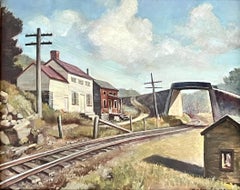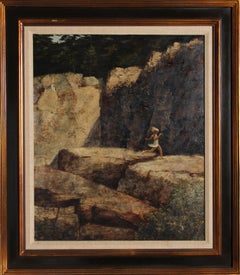Please see accompanying video.
We are a 1stdibs Platinum Seller with 100% 5-star reviews.
One cannot appreciate this painting on a computer screen; in real life, it is absolutely amazing. Because you cannot appreciate it on a computer screen, our gallery has a unique policy. When purchasing from us, the buyer has sixty days to determine if they want to keep the artwork. If not, the buyer returns to piece to us for full refund, and we pay the shipping both ways!
A collector should consider several factors when deciding from whom to purchase artwork online.
Check the location of the seller. When one buys from a foreign seller, one also has to consider the problems of getting the piece through Customs. There are often delays and considerable fees to pay in order to import the item. When purchasing from us, we ship the same day and you receive it via FedEx the next day, no problems or hassles.
When one purchases from an auction house, one pays a buyer’s premium of anywhere from 23% to 28% over the “hammer price”. So when one “wins” an auction for $20,000, the actual price paid is more like $25,000. By contrast, when purchasing from us, the price agreed to is the price paid by the buyer, no hidden fees.
Secondly, when one purchases from an auction house, the buyer pays the packing and shipping fee, which are usually exorbitant. By contrast, when purchasing from us, the price includes packing and shipping.
Thirdly, when one purchases from an auction house, the sale is final. If one receives the piece and is not 100% satisfied with it, there is nothing the buyer can do about it. They are stuck with it. By contrast, when purchasing from us, the buyer has sixty days to determine if they want to keep it. If not, the buyer returns to piece to us for full refund, and we pay the shipping both ways.
About Mark Schiff — Animated by photographs that reflect his personal life, Mark Schiff’s paintings are fueled by what makes him happy. Through his open touch and signature blending method, he lends his artistic perception to the original photographic compositions captured on his Leica.
Mark’s creative vision has been alive since he was a boy. As a child he spent his summers observing life as he rode the trolley back and forth to art classes at the Pratt Institute. During his future travels to Europe, Mark’s eye for light and photography merged with his passion for painting at the Jeu de Paume in Paris; which triggered his career in photorealism.
Mark is well known for painting objects that people can identify and emotionally connect with. His work is distinctly marked by a rich palette and the luminous range of light he paints into his compositions. Each painting is a true extension of his vision and can take up to 200 hours to complete.
Mark Schiff’s work has been commissioned by the well-known brands The Hershey Company and Tropicana. His private collectors include A-list celebrities and also corporate collectors in the US and abroad.
Possessing a strong philanthropic nature, Mark donates both his time and works to charitable organizations such as Big Brothers Big Sisters, The Ronald McDonald House, Make-A-Wish Foundation, The Humane Society and the Special Olympics.
Photorealism is widely viewed as one of this century’s most exciting genres of art. When a photorealistic painting is viewed from afar, it looks like a photograph. Only when getting very close to the art does the viewer realize that it is in fact not a photo, but rather an oil painting.
Photorealism can also refer to sculptures. Duane Hanson is known as the greatest photorealistic sculptor of all time. Some of the greatest photorealistic painters include Mark Schiff, Richard Estes, Ralph Goings, Charles Bell and Audrey Flack.
Photorealist Mark Schiff was born in Bedford Stuyvesant, Brooklyn, in a neighborhood known as a kuchalane, a Yiddish word which Schiff defines as a place where everyone (from the Old Country) ended up living on the same street, and most likely knowing each other’s business. His Russian grandfather came to the US before the revolution and both his parents were first generation American.
Even at five years of age, Mark showed exceptional talent. In the summer, his mother permitted him to travel by himself on the trolley for art classes at the Pratt institute. He continued studying there until he was eleven and the family moved to Great Neck. Except for a few art classes in high school and playing baritone horn in the band, Mark focused on other things besides art, especially when his mother worried for his financial future, kept insisting “that Jewish boys don’t starve to death.” His father made a good living as a production man in textiles so Mark, who had spent years doing the rounds of knitting mills with his father, decided to major in textile chemistry at North Carolina State.
ROTC was mandatory on his campus and he did two years in order to be eligible for officer status. He won the Armed Forces Chemical Association award and thought for sure that he would be assigned chemical work, but instead was made a tank commander and stationed at Fort Knox. Not exactly what his heart yearned for, but a good job awaited him at Sandoz, a Swiss company that made dyestuff. What perfect training for someone who would soon be working in wonderful rich colors on canvas.
He went on to receive his MBA degree from Hofstra University, left Sandoz and was hired to sell at a spinning mill. He liked it. In 1976 he joined Bennett Berman Associates and had an opportunity to buy the spinning mill Spun Fibers.
But what of art? In the early days, Elsie, his wife of fifty-two years, had a problem with the large amount of space his canvases occupied in their one bedroom apartment. Mark took up photography instead, which only required a small darkroom. Photography was a natural ally for his eventual return to painting in the photorealistic style.
It was on his second trip to Europe that Mark fell in love with painting all over again. The impressionistic museum, Jeu de Paume in Paris, renewed his passion and it’s been non-stop since then. Out came the brushes, but this time, he used his love and skill of photography, and built a style based on the photographs he had taken, bringing them to life with paint.
Mark was still not painting to sell until in 1990 when someone discovered and desperately wanted his candy bar (Sweet Series) painting. Mark didn’t want to let go of that particular piece, but was finally convinced to sell it and a second candy painting to this ardent art and candy lover. Two years later, Mark was commissioned to make three paintings of this man’s new Ferrari.
Some of the artists who have inspired his work are Richard Estes, Sandy Scott, Chuck Close, and Charles Bell. He appreciates the work of Ken Keeley, but unlike Keeley’s hard-lined/tape and ruler style, Mark prefers an open touch, using the blending method.
Mark’s subject matters range from candy bars to spice racks to soda cans and soda bottles. He photographs with a Leica M-7 and each painting can take up to 200 or more hours to complete. His palette is rich; his subjects, be it a fire engine or a pretzel cart, take on a luminous quality, always photoreal, but even more beautiful.
Mark developed his own technique for working with bottles by painting a canvas all black, so that the transparency of the bottles allows a wonderful range of light to filter through. The same light and reflection can be seen in the
black rotary phone...






